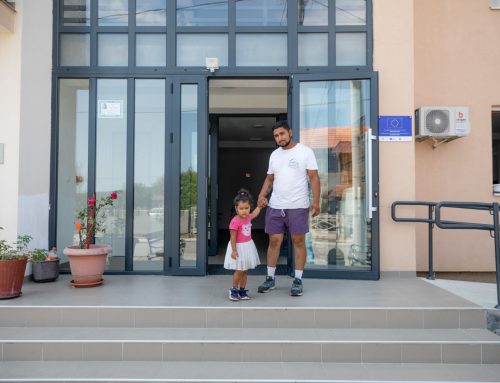Within the Project Support to the implementation of strategies for IDPs, refugees and returnees – legal aid the Round Table on asylum seekers from Serbia in Western Europe was held on 16 March in Belgrade, at the Palace of Serbia. More than 40 representatives of state institutions, international organizations, local authorities and NGOs attended the event.
The focus of the round table was on the assessment of the measures undertaken to decrease the number of asylum seekers from Serbia in Western Countries. The participants discussed the responses to this problem at the EU, national and local levels; how to tackle push factors in Serbia and pull factors in EU countries and how to measure policy impact.
Opening the conference, Massimo Moratti the Team leader of the project mentioned that the focus of the project activities were in obtaining personal documents for returnees/failed asylum seekers, most of whom are Roma. Apart from returnees, the legal aid also includes potential/would-be asylum seekers in Western countries. In this way the project strengthens the inclusion of Roma in Serbia, but it is difficult to assess the impact of this kind of activities in the prevention of future migration flows.
Vladislav Petković, the Assistant Director in the Office for Kosovo and Metohija, beneficiary institution of the Project, said that they are highly concerned about the enhanced number of asylum seekers coming from Kosovo and Metohija.
On behalf of the Delegation of EU to Serbia Marzia Palotta, Programme Manager, Refugees, IDPs and Migration reminded on some recommendations of the European Asylum Support Office toward EU members and states of Western Balkans when it comes to asylum seekers. Those measures include shorter duration of the asylum procedure, lower cash benefits, improving conditions for Roma minorities in the countries of origin and implementations of measure to prevent people to travel abroad in order to lodge unfounded asylum claims.
Speaking about responses to flows of asylum seekers from Serbia Danilo Rakić, Community Officer on the Project said that the increased numbers of Roma temporarily migrating to EU Member States by misusing asylum procedure could have a negative impact on visa-free regime Due to the high cash allowances Germany is the most popular country for asylum seekers from Serbia. From January to October with almost 13,000 requests Serbia was the second country of origin of asylum applicants in Germany.
Milan Barać from the Ministry of Interior said that police officers in the border control procedure regularly check whether travellers have intention to lodge false asylum claims abroad. Also, the Ministry of Interior submitted 30 criminal charges against 36 perpetrators for the criminal offence of organising misuse of the right to asylum in foreign countries.
About the project: The Project Support to the implementation of strategies for IDPs, refugees and returnees – legal aid, is supported by the Delegation of the EU to the Republic of Serbia; the beneficiary institution is the Office for Kosovo and Metohija, while the Commissariat for Refugees and Migration of Serbia is also part of the Project Steering Committee. The aim of this project is to contribute to the realization of the rights of refugees, IDPs and returnees under the readmission process. Regarding returnees, the focus of the Project is on obtaining personal documents in their places of return in Serbia and from abroad. Through the provision of legal aid, the Project has been able to identify and record a number of features of the migration flows towards Western Europe.






